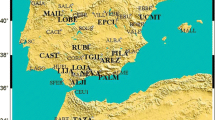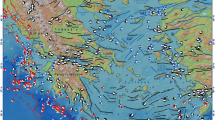Abstract
In this paper, the horizontal crustal movement obtained from GPS observations in 1998 and 2000 at basic and fiducial stations in the Crustal Movement Observation Network of China (CMONOC) is introduced. A brief introduction of the field observations, the data processing with GAMIT/GLOBK software and the accuracy of the GPS observations is given. In average the accuracy of the results for each year is about 2 mm in the horizontal components and 5 mm in the vertical component, and the average accuracy of horizontal displacements at a station is about 3 mm. The results of crustal movement during the period from early September 1998 to mid June, 2000, including the displacements at each station with datum definition of a group of stable stations of insignificant relative movements among themselves in the eastern part of China, strains in different parts of the network and rotations in some parts, are obtained. Based on the crustal movement maps which are more complete and detailed than previous ones, the general characteristics of the recent crustal movement in Chinese mainland are discussed. During the above mentioned period of observations, the crustal deformation in the eastern part of China was relatively small and quite stable. With reference to a group of stable stations with small relative movement in the eastern part of China, the northeastern China block moved northward for about 10 mm, the South China block moved southeastward for about 9 mm. In reference to the eastern part the northwestern part of China moved northward for about 26 mm, the Tibetan area in southwestern part of China moved mainly northward for about 32 mm. The area in Yunnan and east Tibet showed significant clockwise tectonic rotation of 0.0045″ or average rotational displacement of 12 mm with the rotation center at 26.5°N and 95.5°E. The North-South Seismic Belt in the middle part of China is of active and complicated deformation. The observation results show that the northward pushing by the Indian plate has still played the dominant role in the crustal movement in Chinese mainland.
Similar content being viewed by others
References
GU Guo-hua, NIU Hong-ye, ZHENG Gui-ming, et al. 2000. Crustal movement in Chinese mainland observed from 1998 to 1999 [J]. Acta Seismologica Sinica, 13(6): 599–606.
GU Guo-hua, SUN Han-rong, SUN Hui-juan, et al. 1998. Deduction of strain from GPS crustal deformation data in geodetic coordinate system [J]. Crustal Deformation and Earthquake, 18(3): 26–31 (in Chinese).
JIANG Zai-sen, ZHANG Xi, CHEN Wen-sheng, et al. 2000. Study on scale dependence of strain value obtained from crustal deformation data [J]. Acta Seismologica Sinica, 13(4): 375–383.
Author information
Authors and Affiliations
Additional information
Foundation item: National Development and Programing Project for Key Basic Researches (G1998040703).
About this article
Cite this article
Gu, Gh., Shen, Xh., Wang, M. et al. General characteristics of the recent horizontal crustal movement in Chinese mainland. Acta Seimol. Sin. 14, 384–393 (2001). https://doi.org/10.1007/s11589-001-0116-1
Received:
Revised:
Accepted:
Issue Date:
DOI: https://doi.org/10.1007/s11589-001-0116-1




